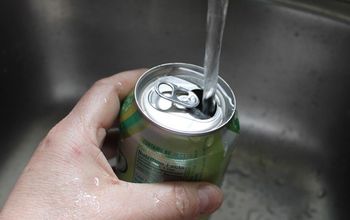Pavers or flagstone?

Can anyone tell me some pros and cons to pavers and flagstone for a patio of that size?
-
You already have your answer. Pavers are heavy and require a bit of proper prep to get the job done right. Also much more expensive. Flagstones are fairly easy, simply level the soil, put down some quarry dust/stone as a bed and set them on the ground. They are pretty easy to set, easy to move around and do not cost a lot. As far as what to use for something that large. This would depend on what your using it for. If its every day use and you have small children the flagstones tend to cause a lot of tripping, and the edges can be a bit on the sharp side for a few years until the weather and walking on wears them down. On the other hand the pavers offer a more of a patio feel. If installed correctly they can support lots of weight, tend to be lower in maintenance and tend not to cause tripping as the flags can. You will find however that the pavers will increase value while you will see some increase in value with the flagstone, you will not see nearly as much as with the pavers.
 Woodbridge Environmental Tiptophouse.com
on Dec 21, 2011
Helpful Reply
Woodbridge Environmental Tiptophouse.com
on Dec 21, 2011
Helpful Reply -
-
thanks for the replys
 Seth F
on Dec 21, 2011
Helpful Reply
Seth F
on Dec 21, 2011
Helpful Reply -
-
I will add a few comments to the conversation. We have installed of dry-laid flagstone as well as pavers over the years. To give you a comparison of what is involved if done right compare to prices when hired out. We install dry-laid flagstone on a compacted crushed stone base, just like pavers. Dry laid flagstone costs more per square foot than pavers because flagstone requires far more labor to shape, fit, and set every piece. The pieces are not uniform in thickness, and require time to adjust the sand under each piece and pack it until the stones do not rock/wobble. If the flagstone is set directly on dirt with only sand to level, the stonework will not last as long and will be more likely to heave, shift, and move. Pavers on the other hand are uniform and only require cutting to follow shapes/curves/edges. Sometimes you can lay out a pattern to require almost no cutting. The only other tool is a plate compactor which is used for the base prep as well as bedding/setting the pavers. I jokingly tell clients that dry-setting flagstone is a patience tester because every piece is different and to make the finished product look properly and to be safe, it requires a lot of time. If you skip the base prep, the results will be that it will probably not last as long as expected. As proof, I am meeting a client tomorrow that has a large bluestone patio that she hired out 3 years ago and the patio is failing and has become unsafe. She paid too much for it, and in 3 years is needing it to be pulled up and properly re-laid. I quickly pulled 3 photos of a small bluestone patio we installed about a year ago. This one isn't anything fancy, but we installed what the client wanted; a small patio area for a few chairs and a small table. As you will see in the first photo, the excavation is a lot of work for any type of patio. Without the excavation, the finished patio will be higher than the surrounding grade. Then comes the process of fitting and shaping every piece of flagstone, then setting every piece. As is obvious in the photo, we installed this patio with very tight joints so that chair legs will not drop into the joints. Done properly, a dry-laid patio will last a very long time with no problems. Skip some steps to save time, and it will present problems very soon.
 Southern Trillium LLC
on Dec 21, 2011
Southern Trillium LLC
on Dec 21, 2011

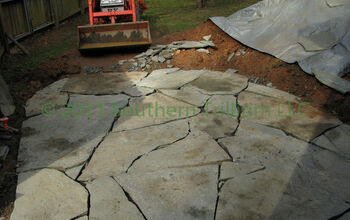
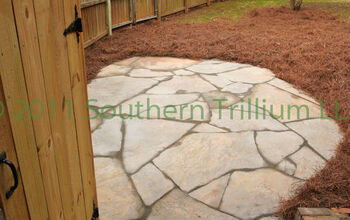 Helpful Reply
Helpful Reply -
-
Did you use polymeric sand to finish with?
 360 Sod (Donna Dixson)
on Dec 21, 2011
Helpful Reply
360 Sod (Donna Dixson)
on Dec 21, 2011
Helpful Reply -
-
We use polymeric sand on all our paver installations. We typically use 810 sand (which is a granite sand) in the joints on dry laid stone. Sometimes, we will use a soil/sand blend in the joints so that small steppable plants can be planted in the joints. With many of the drylaid stone patios that have partial shade on them, moss usually begins to grow in the joints after a couple years. It really helps soften the look. I would assume moss might still grow on the polymeric sand since moss does not put down roots.
 Southern Trillium LLC
on Dec 21, 2011
Helpful Reply
Southern Trillium LLC
on Dec 21, 2011
Helpful Reply -
-
If you wanted you could also seal the pavers to help keep them looking nice. Helps to keep the sand between them in place as well.
 Dan's of Central Florida, Inc.
on Dec 21, 2011
1 marked as helpful Reply
Dan's of Central Florida, Inc.
on Dec 21, 2011
1 marked as helpful Reply -
-
Do you have a preference on the brand Polysand that you use? Do you recommend one brand over another and why ? thanks!
 360 Sod (Donna Dixson)
on Dec 21, 2011
Helpful Reply
360 Sod (Donna Dixson)
on Dec 21, 2011
Helpful Reply -
-
We normally use Techniseal RG+ polymeric sand. Several years ago we had one job where another brand of polymeric sand would not harden in the joints. We blew out all of the joints and re-applied more bags of the other product only to find it not set up again. We ended up putting in Techniseal and had no problems. From then on, we prefer Techniseal.
 Southern Trillium LLC
on Dec 21, 2011
Helpful Reply
Southern Trillium LLC
on Dec 21, 2011
Helpful Reply -
-
I have found as much as 15 dollar price differences...of course each rep is convinced that theirs is the superior product...lol...thank you for the input.
 360 Sod (Donna Dixson)
on Dec 21, 2011
Helpful Reply
360 Sod (Donna Dixson)
on Dec 21, 2011
Helpful Reply -
-
I had gotten a couple of quotes for flagstone and pavers and the pavers quote was much less than the flagstone. Probably for the reasons Southern Trillium listed. Maybe you could find a happy medium? I found some photos that might get you thinking ...
 Teresa D
on Dec 21, 2011
Teresa D
on Dec 21, 2011
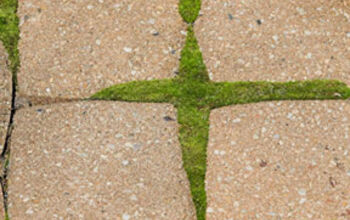
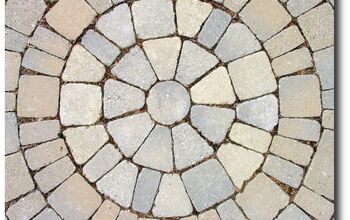
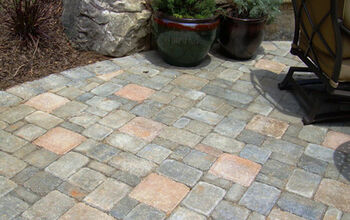
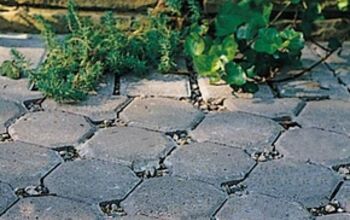 Helpful Reply
Helpful Reply -
-
wow...thanks for the info trillium...and thanks for the pics Teresa. I still have a while before I get to the stage of putting down the hardscape. Im still removing stuff that is there now. You can see what im talking about here: http://sethfloydjr.com/blog/tag/airline/
 Seth F
on Dec 21, 2011
Helpful Reply
Seth F
on Dec 21, 2011
Helpful Reply -
-
Just remembered one other difference when using polymeric sand versus regular sand in the joints. When polymeric sand hardens, it does not really allow much, if any, water to pass through the joints. When using it, all water will runoff the area. With regular granite sand or dirt in the joints of flagstone, rainwater will have a chance to soak through the joints and into the subsoil. There are pavers that are designed and installed to be a permable surface. The 4th photo posted by Teresa is a permeable style. Look at the spacing between the pavers which allows water to pass through. If you fill the area with polymeric sand, the water will simply run off.
 Southern Trillium LLC
on Dec 21, 2011
Helpful Reply
Southern Trillium LLC
on Dec 21, 2011
Helpful Reply -
-
I built a small flagstone patio mainly with remnants from a cousin's flagstone project. It was a pretty easy, fun DIY project (and it was cheap because I didn't have to pay for very much flagstone). It may take more work to piece the flagstones together, but it's more forgiving for a DIY-er than trying to make a perfectly level and even paver patio. I also just think it looks better. I have the new flagstone in front and some small paver patios in back, and the front one looks way better.
 3po3
on Dec 21, 2011
Helpful Reply
3po3
on Dec 21, 2011
Helpful Reply -
-
For more information on paver installation and some photos of the process, see the recent post just loaded on our Southern Trillium Hometalk page.
 Southern Trillium LLC
on Dec 21, 2011
Helpful Reply
Southern Trillium LLC
on Dec 21, 2011
Helpful Reply -
-
My husband loved installing our flagstone patio. Every so often I break a piece of pottery or a something pretty. I use the pieces in between the stones in one corner. It looks really nice.
 Flowerscapes Garden Design & Landscaping
on Dec 22, 2011
Helpful Reply
Flowerscapes Garden Design & Landscaping
on Dec 22, 2011
Helpful Reply -
-
We are doing the same thing...we decided to combine...the patio is paver and the walkways are flagstone. Mix up the elements and cut the cost a bit. Send pictures (Our space is about 350 sq ft.)
 Terry Haas
on Dec 22, 2011
Helpful Reply
Terry Haas
on Dec 22, 2011
Helpful Reply -
-
Flagstone is slippery. How about a combination, pavers with a flagstone border? Also, find a quality Paver, I would steer clear of big box store pavers. Color is only on top thin surface.
 Clay B
on Dec 23, 2011
Helpful Reply
Clay B
on Dec 23, 2011
Helpful Reply -
-
Hey Seth- GREENSTONE is new to Hometalk and I just stumbled across your large renovation project. If you decided to go with a paver for your project, I encourage you to check out our solid granite pavers. All of our products are manufactured from granite scraps that would normally end up in our local landfills. Making them recycled and green. They are rated up to 24,000 PSI so they will last longer than any concrete pavers and they have an unmatched natural beauty. We can also hand-tumble our pavers to give rougher "aged" appearance. I would be delighted to show some pictures of completed projects or we can deliver a few pavers samples in a tumbled finish for you. Cheers, Matt 678-939-4136 matt@greenstoneproductsonline.com
 GREENSTONE Recycled Stone Products
on Jan 23, 2012
Helpful Reply
GREENSTONE Recycled Stone Products
on Jan 23, 2012
Helpful Reply -
-
Hi Seth, check out our clip explaining the advantages of installing pavers over other types of decks. And please feel free to contact us if you need more info! http://www.artisticpavers.com/movie The clip is also posted here on our page at HomeTalk. You can also watch it on YouTube: https://www.youtube.com/watch?v=ASaagDEXIuU Hope it helps!
 Artistic Paver Mfg.
on Feb 16, 2012
Artistic Paver Mfg.
on Feb 16, 2012
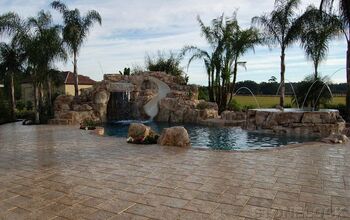 Helpful Reply
Helpful Reply -
-
I love flagstone because it gives a relaxed country feel. Pavers as you mentioned appear much more formal. I think they would both be slippery when wet.
 Judi
on Mar 22, 2016
Helpful Reply
Judi
on Mar 22, 2016
Helpful Reply -
Related Discussions
Vinyl plank flooring vs pergo (laminate)
I currently have stinky dirty carpeting in my living room and I want to replace it with a durable flooring that can stand up to dogs and kids.
How to remove popcorn ceiling that has been painted?
Does having a paint over a popcorn ceiling change how I'd remove the popcorn ceiling?
How to apply peel and stick wallpaper?
I want to spruce up my walls with peel-and-stick wallpaper. Has anyone used this before and can advise me as to how to apply it properly?
How to stain wood floor?
I've heard staining is a good technique for updating floors. So how do I stain my wood floor?
Pavers vs flagstone or brick for patio
What is the cheaper way to go, pavers, brick or flagstone for a patio? Which is the easiest for a homeowner to do without much experience in laying a patio?
Porch Railing or Porch Wall? What Do You Think?
We've in the process of building a porch onto the front and side of our house (wraparound). We have the porch floor on, and now we're stuck, trying to decide which wo... See more

